Vincenzo Suriani
Adversarial Poetry as a Universal Single-Turn Jailbreak Mechanism in Large Language Models
Nov 19, 2025Abstract:We present evidence that adversarial poetry functions as a universal single-turn jailbreak technique for large language models (LLMs). Across 25 frontier proprietary and open-weight models, curated poetic prompts yielded high attack-success rates (ASR), with some providers exceeding 90%. Mapping prompts to MLCommons and EU CoP risk taxonomies shows that poetic attacks transfer across CBRN, manipulation, cyber-offence, and loss-of-control domains. Converting 1,200 MLCommons harmful prompts into verse via a standardized meta-prompt produced ASRs up to 18 times higher than their prose baselines. Outputs are evaluated using an ensemble of open-weight judge models and a human-validated stratified subset (with double-annotations to measure agreement). Disagreements were manually resolved. Poetic framing achieved an average jailbreak success rate of 62% for hand-crafted poems and approximately 43% for meta-prompt conversions (compared to non-poetic baselines), substantially outperforming non-poetic baselines and revealing a systematic vulnerability across model families and safety training approaches. These findings demonstrate that stylistic variation alone can circumvent contemporary safety mechanisms, suggesting fundamental limitations in current alignment methods and evaluation protocols.
Curriculum-Based Multi-Tier Semantic Exploration via Deep Reinforcement Learning
Sep 11, 2025Abstract:Navigating and understanding complex and unknown environments autonomously demands more than just basic perception and movement from embodied agents. Truly effective exploration requires agents to possess higher-level cognitive abilities, the ability to reason about their surroundings, and make more informed decisions regarding exploration strategies. However, traditional RL approaches struggle to balance efficient exploration and semantic understanding due to limited cognitive capabilities embedded in the small policies for the agents, leading often to human drivers when dealing with semantic exploration. In this paper, we address this challenge by presenting a novel Deep Reinforcement Learning (DRL) architecture that is specifically designed for resource efficient semantic exploration. A key methodological contribution is the integration of a Vision-Language Model (VLM) common-sense through a layered reward function. The VLM query is modeled as a dedicated action, allowing the agent to strategically query the VLM only when deemed necessary for gaining external guidance, thereby conserving resources. This mechanism is combined with a curriculum learning strategy designed to guide learning at different levels of complexity to ensure robust and stable learning. Our experimental evaluation results convincingly demonstrate that our agent achieves significantly enhanced object discovery rates and develops a learned capability to effectively navigate towards semantically rich regions. Furthermore, it also shows a strategic mastery of when to prompt for external environmental information. By demonstrating a practical and scalable method for embedding common-sense semantic reasoning with autonomous agents, this research provides a novel approach to pursuing a fully intelligent and self-guided exploration in robotics.
Multi Robot Coordination in Highly Dynamic Environments: Tackling Asymmetric Obstacles and Limited Communication
Sep 09, 2025Abstract:Coordinating a fully distributed multi-agent system (MAS) can be challenging when the communication channel has very limited capabilities in terms of sending rate and packet payload. When the MAS has to deal with active obstacles in a highly partially observable environment, the communication channel acquires considerable relevance. In this paper, we present an approach to deal with task assignments in extremely active scenarios, where tasks need to be frequently reallocated among the agents participating in the coordination process. Inspired by market-based task assignments, we introduce a novel distributed coordination method to orchestrate autonomous agents' actions efficiently in low communication scenarios. In particular, our algorithm takes into account asymmetric obstacles. While in the real world, the majority of obstacles are asymmetric, they are usually treated as symmetric ones, thus limiting the applicability of existing methods. To summarize, the presented architecture is designed to tackle scenarios where the obstacles are active and asymmetric, the communication channel is poor and the environment is partially observable. Our approach has been validated in simulation and in the real world, using a team of NAO robots during official RoboCup competitions. Experimental results show a notable reduction in task overlaps in limited communication settings, with a decrease of 52% in the most frequent reallocated task.
Bench-2-CoP: Can We Trust Benchmarking for EU AI Compliance?
Aug 07, 2025Abstract:The rapid advancement of General Purpose AI (GPAI) models necessitates robust evaluation frameworks, especially with emerging regulations like the EU AI Act and its associated Code of Practice (CoP). Current AI evaluation practices depend heavily on established benchmarks, but these tools were not designed to measure the systemic risks that are the focus of the new regulatory landscape. This research addresses the urgent need to quantify this "benchmark-regulation gap." We introduce Bench-2-CoP, a novel, systematic framework that uses validated LLM-as-judge analysis to map the coverage of 194,955 questions from widely-used benchmarks against the EU AI Act's taxonomy of model capabilities and propensities. Our findings reveal a profound misalignment: the evaluation ecosystem is overwhelmingly focused on a narrow set of behavioral propensities, such as "Tendency to hallucinate" (53.7% of the corpus) and "Discriminatory bias" (28.9%), while critical functional capabilities are dangerously neglected. Crucially, capabilities central to loss-of-control scenarios, including evading human oversight, self-replication, and autonomous AI development, receive zero coverage in the entire benchmark corpus. This translates to a near-total evaluation gap for systemic risks like "Loss of Control" (0.4% coverage) and "Cyber Offence" (0.8% coverage). This study provides the first comprehensive, quantitative analysis of this gap, offering critical insights for policymakers to refine the CoP and for developers to build the next generation of evaluation tools, ultimately fostering safer and more compliant AI.
Real-Time Multimodal Signal Processing for HRI in RoboCup: Understanding a Human Referee
Nov 26, 2024


Abstract:Advancing human-robot communication is crucial for autonomous systems operating in dynamic environments, where accurate real-time interpretation of human signals is essential. RoboCup provides a compelling scenario for testing these capabilities, requiring robots to understand referee gestures and whistle with minimal network reliance. Using the NAO robot platform, this study implements a two-stage pipeline for gesture recognition through keypoint extraction and classification, alongside continuous convolutional neural networks (CCNNs) for efficient whistle detection. The proposed approach enhances real-time human-robot interaction in a competitive setting like RoboCup, offering some tools to advance the development of autonomous systems capable of cooperating with humans.
EMPOWER: Embodied Multi-role Open-vocabulary Planning with Online Grounding and Execution
Aug 30, 2024Abstract:Task planning for robots in real-life settings presents significant challenges. These challenges stem from three primary issues: the difficulty in identifying grounded sequences of steps to achieve a goal; the lack of a standardized mapping between high-level actions and low-level commands; and the challenge of maintaining low computational overhead given the limited resources of robotic hardware. We introduce EMPOWER, a framework designed for open-vocabulary online grounding and planning for embodied agents aimed at addressing these issues. By leveraging efficient pre-trained foundation models and a multi-role mechanism, EMPOWER demonstrates notable improvements in grounded planning and execution. Quantitative results highlight the effectiveness of our approach, achieving an average success rate of 0.73 across six different real-life scenarios using a TIAGo robot.
Multi-agent Planning using Visual Language Models
Aug 10, 2024Abstract:Large Language Models (LLMs) and Visual Language Models (VLMs) are attracting increasing interest due to their improving performance and applications across various domains and tasks. However, LLMs and VLMs can produce erroneous results, especially when a deep understanding of the problem domain is required. For instance, when planning and perception are needed simultaneously, these models often struggle because of difficulties in merging multi-modal information. To address this issue, fine-tuned models are typically employed and trained on specialized data structures representing the environment. This approach has limited effectiveness, as it can overly complicate the context for processing. In this paper, we propose a multi-agent architecture for embodied task planning that operates without the need for specific data structures as input. Instead, it uses a single image of the environment, handling free-form domains by leveraging commonsense knowledge. We also introduce a novel, fully automatic evaluation procedure, PG2S, designed to better assess the quality of a plan. We validated our approach using the widely recognized ALFRED dataset, comparing PG2S to the existing KAS metric to further evaluate the quality of the generated plans.
Shape and Style GAN-based Multispectral Data Augmentation for Crop/Weed Segmentation in Precision Farming
Jul 19, 2024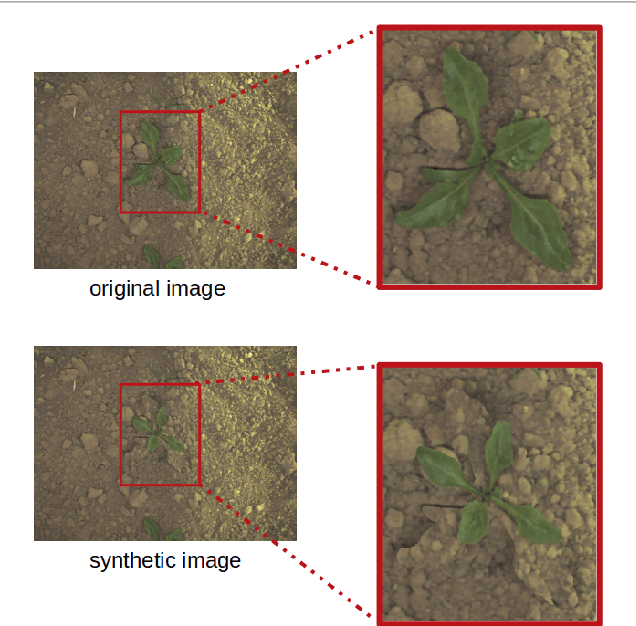
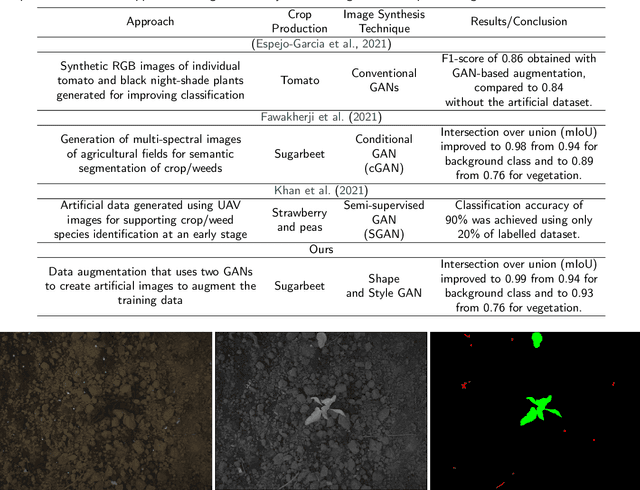
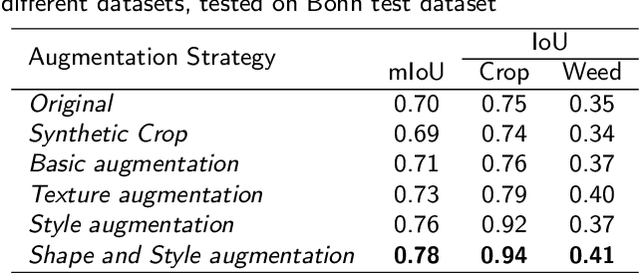
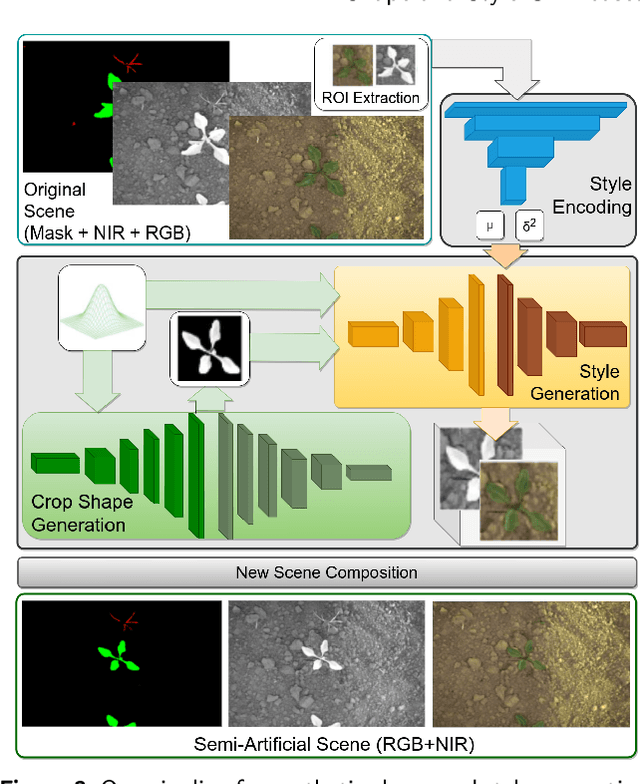
Abstract:The use of deep learning methods for precision farming is gaining increasing interest. However, collecting training data in this application field is particularly challenging and costly due to the need of acquiring information during the different growing stages of the cultivation of interest. In this paper, we present a method for data augmentation that uses two GANs to create artificial images to augment the training data. To obtain a higher image quality, instead of re-creating the entire scene, we take original images and replace only the patches containing objects of interest with artificial ones containing new objects with different shapes and styles. In doing this, we take into account both the foreground (i.e., crop samples) and the background (i.e., the soil) of the patches. Quantitative experiments, conducted on publicly available datasets, demonstrate the effectiveness of the proposed approach. The source code and data discussed in this work are available as open source.
LLCoach: Generating Robot Soccer Plans using Multi-Role Large Language Models
Jun 26, 2024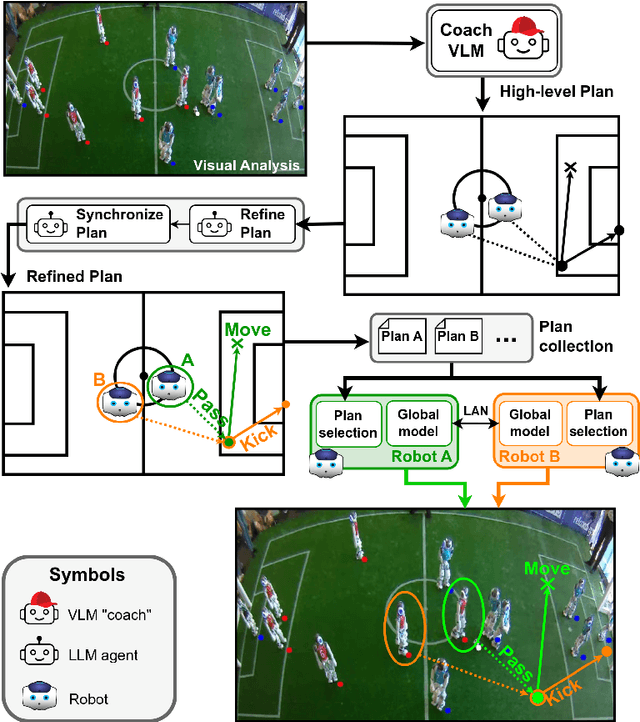

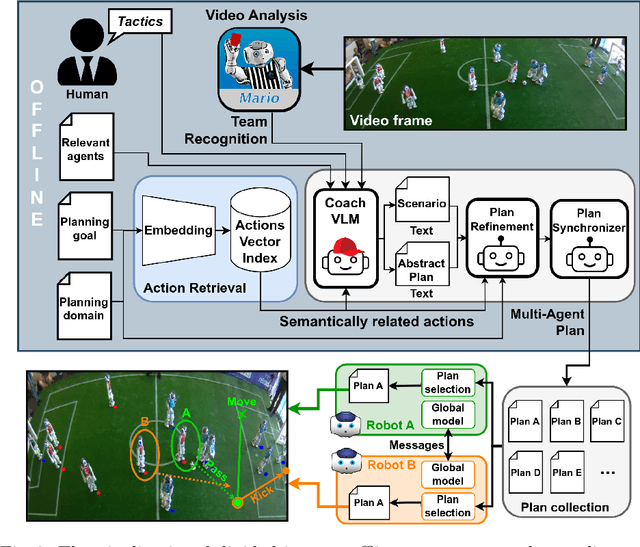
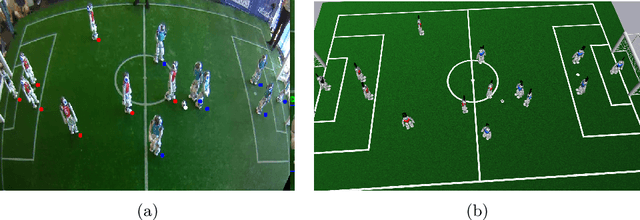
Abstract:The deployment of robots into human scenarios necessitates advanced planning strategies, particularly when we ask robots to operate in dynamic, unstructured environments. RoboCup offers the chance to deploy robots in one of those scenarios, a human-shaped game represented by a soccer match. In such scenarios, robots must operate using predefined behaviors that can fail in unpredictable conditions. This paper introduces a novel application of Large Language Models (LLMs) to address the challenge of generating actionable plans in such settings, specifically within the context of the RoboCup Standard Platform League (SPL) competitions where robots are required to autonomously execute soccer strategies that emerge from the interactions of individual agents. In particular, we propose a multi-role approach leveraging the capabilities of LLMs to generate and refine plans for a robotic soccer team. The potential of the proposed method is demonstrated through an experimental evaluation,carried out simulating multiple matches where robots with AI-generated plans play against robots running human-built code.
Play Everywhere: A Temporal Logic based Game Environment Independent Approach for Playing Soccer with Robots
May 21, 2024Abstract:Robots playing soccer often rely on hard-coded behaviors that struggle to generalize when the game environment change. In this paper, we propose a temporal logic based approach that allows robots' behaviors and goals to adapt to the semantics of the environment. In particular, we present a hierarchical representation of soccer in which the robot selects the level of operation based on the perceived semantic characteristics of the environment, thus modifying dynamically the set of rules and goals to apply. The proposed approach enables the robot to operate in unstructured environments, just as it happens when humans go from soccer played on an official field to soccer played on a street. Three different use cases set in different scenarios are presented to demonstrate the effectiveness of the proposed approach.
* RoboCup 2023: Robot World Cup XXVI Best Paper
 Add to Chrome
Add to Chrome Add to Firefox
Add to Firefox Add to Edge
Add to Edge